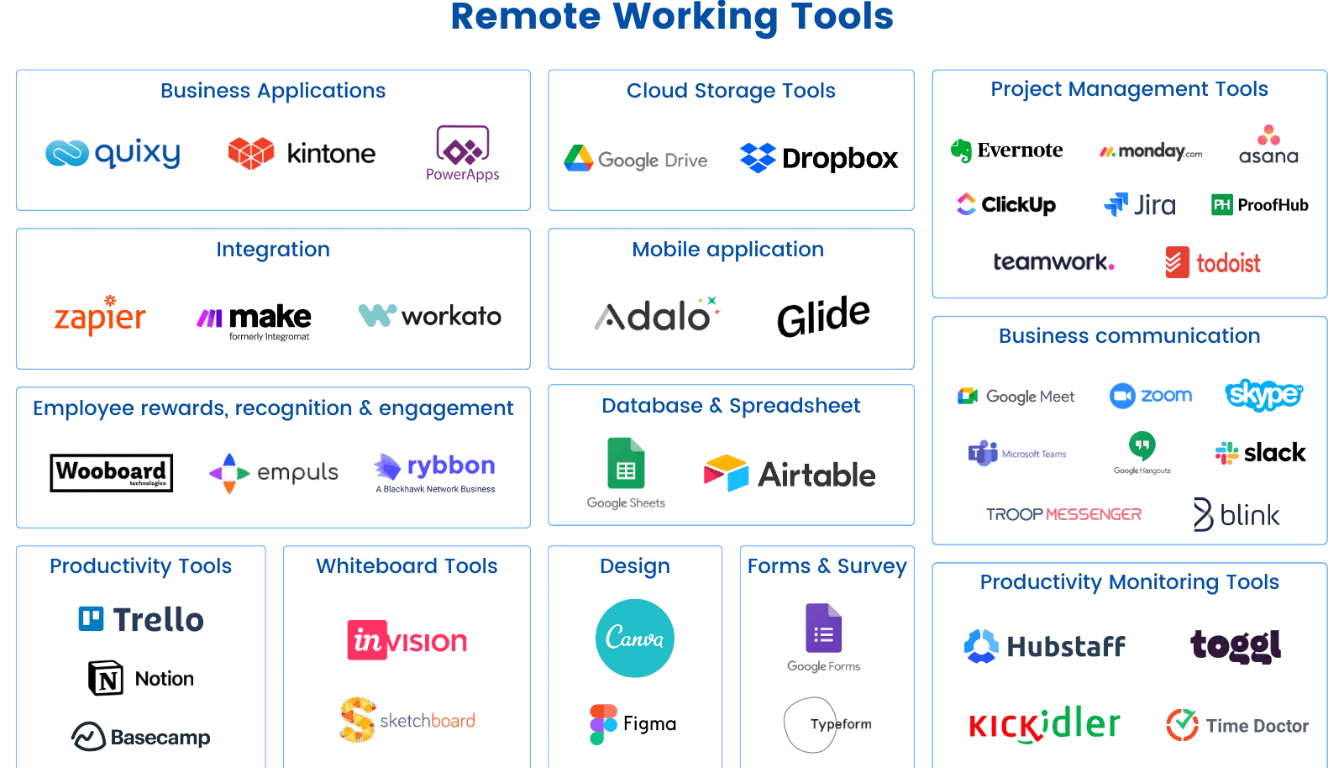Top Strategies for Managing Remote Workforce Effectively

Wondering how to manage a remote workforce successfully? As remote work grows, leaders face unique challenges in managing a remote workforce, including maintaining communication, productivity, and team morale. This article provides essential strategies and tools to help you navigate these challenges and lead your remote workforce effectively.
Key Takeaways
- Set clear expectations and guidelines for communication, responsibilities, and deliverables to enhance alignment among remote employees.
- Invest in the right collaboration tools and resources to support remote work efficiency, productivity, and employee well-being.
- Foster personal connections and a positive remote work culture through intentional communication, team bonding activities, and regular check-ins.
Set Clear Expectations for Remote Employees

Setting clear expectations is the cornerstone of effective remote workforce management. When employees work remotely, the lack of physical presence can lead to confusion about priorities and responsibilities. Clear guidance on response times and performance metrics helps remote employees align with company goals and set expectations to avoid misunderstandings.
Remote team members should feel encouraged to share their needs and feedback as a team member. This not only fosters better collaboration but also helps in identifying potential issues before they escalate. Clear expectations should include detailed guidelines on communication, work hours, and deliverables. This ensures all employees are aligned and empowered to perform their best.
Invest in the Right Tools for Remote Work

The right tools are crucial for managing remote employees effectively. Remote workers rely heavily on technology to stay connected and productive. Reliable communication tools, such as video conferencing software and collaboration platforms, are crucial for seamless interaction and teamwork. Tools like ActivTrak Coach can also enhance productivity and performance by providing insights into how employees work across different locations and time zones.
Ergonomic support and resources for home offices can significantly enhance employee comfort and productivity. Ensuring that remote team members have access to reliable remote access tools enables them to perform their tasks from anywhere, promoting flexibility in work environments. These tools create an environment where remote workers can thrive and contribute effectively to the team’s success.
The right tools also include project management software that facilitates real-time collaboration and communication. These tools help in tracking progress, managing tasks, and ensuring that everyone is on the same page. Equipping your remote team with the necessary tools empowers them to work efficiently and maintain high productivity.
Foster Strong Personal Connections
Fostering strong personal connections among remote team members is vital for maintaining morale and reducing feelings of isolation. Informal interactions, like virtual water cooler chats and team bonding activities, significantly enhance team dynamics. These interactions help remote employees feel connected and valued, boosting morale and collaboration.
Regular one-on-one check-ins and dedicated Slack channels for positive feedback strengthen team relationships. Celebrating small milestones and gathering feedback from team members before planning events ensures that everyone feels included and appreciated. Additionally, one-on-ones meetings can enhance communication and trust within the team, leading to great ideas.
A psychologically safe environment where employees can share ideas and feedback builds a stronger and more cohesive team.
Communicate Intentionally and Frequently
Frequent, intentional communication is key to managing remote teams effectively. Overcommunicate rather than under-communicate to ensure that everyone is informed and aligned. Regular updates on project progress and company changes keep remote employees engaged and motivated.
Empathy plays a crucial role in remote communication. Active listening and clarifying questions foster better team connections and improve workplace culture. Establishing regular check-ins and planning intentional conversations with team members can significantly enhance team dynamics and ensure everyone feels heard and valued.
Daily check-ins and regular meetings are recommended to maintain team connection and ensure that everyone receives the same information. Techniques such as actively listening and repeating back during conversations help ensure understanding and clarity. Prioritizing intentional and frequent communication builds stronger relationships and maintains a cohesive and productive remote team.
Monitor and Support Employee Well-being
Monitoring and supporting employee well-being prevent burnout and enhance productivity in a remote work environment. Regular recognition of contributions and promoting work-life balance mitigate stress and improve overall wellness. Employers should encourage regular breaks and time off to combat burnout and enhance long-term health.
Investing in wellness programs and virtual mental health resources can significantly support remote employees’ physical and mental health. Loneliness is a significant issue for remote workers and can lead to higher levels of anxiety and depression, causing many to feel isolated.
Offering digital health programs and promoting a culture of recognition and appreciation boosts morale and reinforces a sense of belonging within your remote workforce.
Create a Positive Remote Work Culture

A positive remote work culture is crucial for employee engagement and productivity. Defining and regularly updating your company culture guides remote employees and ensures alignment with company values and priorities. A strong culture in a remote work environment fosters engagement and creates a sense of community among employees.
Integrating company values into remote team interactions through one-on-one conversations, meetings, and team-building activities can strengthen the culture. A culture of transparency and trust is essential for the morale of remote teams. Flexibility in work arrangements is increasingly expected by employees, so a well-defined remote work policy is important to attract and retain talent.
Curated off-site experiences enhance company culture by fostering connections and clarifying expectations. These experiences help manage and motivate remote employees long after the event ends, creating a lasting positive impact on the employee experience and the team.
Implement Effective Remote Work Policies
Implementing effective remote work policies is essential for ensuring clarity and compliance among remote employees. A comprehensive communication policy that clarifies the appropriate use of various communication tools helps prevent misunderstandings and ensures effective communication. Remote work policies should also cover insurance and liability considerations to ensure safety and compliance.
Regularly reviewing and updating remote work policies in collaboration with legal, HR, and IT departments is crucial for ongoing compliance. These policies should outline clear guidelines on job duties, working hours, technical support, and data security measures to protect sensitive information.
Effective remote work policies create a structured and secure environment to manage your remote workforce in a remote workplace.
Facilitate Team Collaboration and Interaction
Team collaboration and interaction are key to enhancing productivity and engagement in a remote setting. Tools that facilitate remote collaboration, such as project management software and video conferencing platforms, ensure high productivity among distributed teams. These tools allow for real-time sharing of ideas and information, making collaboration more effective.
Virtual social events, like happy hours or book clubs, foster team bonding among remote employees. Encouraging the use of video calls can enhance communication effectiveness and create a more collaborative environment through virtual meetings and virtual events.
Promoting social interactions and utilizing collaboration tools builds stronger relationships and enhances team productivity.
Track Progress and Productivity
Tracking progress and productivity ensures accountability and effective resource allocation in a remote work environment. Time-tracking tools and a clear timesheet policy enhance transparency and accountability. Regular performance evaluations using data from tracking software provide objective feedback to remote employees and help identify areas for improvement.
Accurate tracking of work hours is essential for ensuring compliance with labor laws and maintaining consistency in recording work hours. Tracking progress and productivity allows managers to allocate resources effectively and ensure remote team members are neither overloaded nor underutilized.
Encourage Flexibility and Work-Life Balance

Flexibility and work-life balance are crucial for maintaining employee satisfaction and productivity. A flexible work environment promotes employee autonomy and enhances well-being. Offering flexible scheduling allows employees to better align their work responsibilities with personal commitments, promoting a healthier work-life balance.
Leaders should model healthy work-life balance behaviors to encourage employees to prioritize their own well-being. Establishing availability guidelines for remote team members helps prevent miscommunication and accommodates time differences, following best practices.
Promoting flexibility and work-life balance creates a more satisfied and productive remote workforce while working remotely.
Provide Training Opportunities
Training opportunities are essential for continuous skill development and employee engagement. Offering personal and professional development opportunities helps employees feel valued and invested in their roles. Remote training can cater to employees’ unique learning preferences by utilizing various engaging formats, such as videos, webinars, and interactive tasks.
Incorporating self-paced learning options allows remote employees the flexibility to complete training at their convenience, accommodating diverse schedules. Gathering feedback from training participants is crucial for understanding training effectiveness and identifying areas for improvement.
Continuous training opportunities empower employees to increase productivity and collaboration.
Empower Employees with Autonomy
Employee autonomy fosters increased motivation and productivity. Allowing individuals to make choices about how, when, and where they accomplish their work tasks helps them feel trusted and confident in their abilities. Focusing on goal achievement rather than micromanaging processes is crucial for maintaining employee autonomy.
Employees can be held accountable for their tasks by tying performance to controllable metrics and having them report on progress and obstacles. Empowering employees with autonomy creates a motivated and productive remote workforce capable of achieving great results, especially when you manage remote employees effectively.
Plan for Technical Difficulties
Start by listing a few ideas for your challenging task tool project to ensure you have clear ground rules, considering many factors.
Planning for technical difficulties maintains productivity in a remote work environment. Common technical challenges include internet issues, camera problems, audio fluctuations, and app malfunctions. Teams should work with IT for quick fixes and solutions when facing technical difficulties.
After reviewing the text, it appears that there is an opportunity to incorporate the keyword “challenge” without altering the meaning or adding unsupported information.
Common technical challenges in a remote work environment include:
- Internet issues
- Camera problems
- Audio fluctuations
- App malfunctions
Teams should work with IT for quick fixes and solutions when facing technical difficulties.
Having a backup internet connection, like a mobile hotspot, can prevent disruptions during remote work. A secondary device, such as a tablet or spare computer, can serve as a temporary solution if your primary computer fails.
Planning for technical difficulties ensures your remote team remains productive and resilient in the face of challenges.
Organize Regular In-Person Meetings

Regular in-person meetings are crucial for strengthening relationships among remote team members. Remote teams should aim to meet in person at least once a year, and more frequently if possible. These meetings can boost productivity by minimizing distractions common in virtual settings.
Physical meetings allow for better engagement and spontaneous interactions, improving overall meeting effectiveness. Non-traditional team activities during in-person meetings can foster stronger relationships and improve team dynamics.
By organizing regular in-person team meetings, you create opportunities for deeper connections and enhanced team collaboration.
Summary
In summary, managing a remote workforce requires a combination of clear expectations, the right tools, strong personal connections, intentional communication, and support for employee well-being. By creating a positive remote work culture, implementing effective policies, and facilitating collaboration, you can enhance productivity and engagement within your remote team. Companies like Offsite support this by offering curated retreat experiences that strengthen team connection, align goals, and reinforce company culture beyond the virtual workspace.
Remember, flexibility and work-life balance are crucial for maintaining employee satisfaction, while continuous training and autonomy empower employees to perform their best. By planning for technical difficulties and organizing regular in-person meetings, you can overcome challenges and create a thriving remote workplace.
FAQs
- Why is it important to set clear expectations for remote employees?
Setting clear expectations for remote employees is crucial as it minimizes confusion, aligns their efforts with company goals, and empowers them to perform optimally. This clarity enhances overall productivity and engagement.
- What tools are essential for remote work?
Essential tools for remote work are reliable communication platforms, project management software, ergonomic support, and remote access tools to ensure efficiency and comfort. Prioritizing these will enhance your remote work experience.
- How can managers support employee wellbeing in a remote setting?
Managers can enhance employee wellbeing in a remote setting by promoting work-life balance, implementing wellness programs, and recognizing individual contributions. These actions create a supportive atmosphere that fosters employee satisfaction and productivity.
- Why is it important to organize regular in-person meetings for remote teams?
Organizing regular in-person meetings for remote teams is crucial as it strengthens relationships, boosts productivity, and enhances engagement through spontaneous interactions. These gatherings cultivate a cohesive work environment that ultimately drives team performance.
You may also like
Unique spaces for your next offsite
Find distinctive venues for your upcoming corporate retreat.
Stay Updated with Our Insights
Get exclusive content and valuable updates directly to you.







